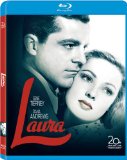| Reviews & Columns |
|
Reviews DVD TV on DVD Blu-ray 4K UHD International DVDs In Theaters Reviews by Studio Video Games Features Collector Series DVDs Easter Egg Database Interviews DVD Talk Radio Feature Articles Columns Anime Talk DVD Savant Horror DVDs The M.O.D. Squad Art House HD Talk Silent DVD
|
DVD Talk Forum |
|
|
| Resources |
|
DVD Price Search Customer Service #'s RCE Info Links |
|
Columns
|
|
|
Laura
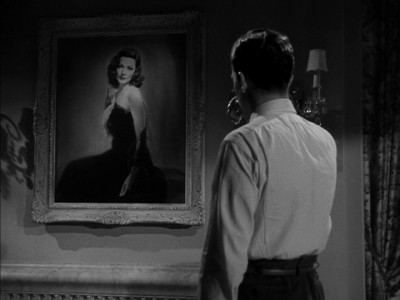
Please Note: The images used here are taken from the 2005 DVD edition, not the Blu-ray disc under review.
The opening credits of Otto Preminger's Laura come up over an instantly captivating, then eternally unforgettable piece of cinematic iconography: A painted portrait of the title character (Gene Tierney, whom the film's producer, Fox's (in)famous Darryl F. Zanuck, once very understandably referred to as "The most beautiful woman in movie history"), which gazes out at us with a mixture of allure, defiance, and forbidding that might make even the Mona Lisa blush. As a whole, the film is Preminger's equally overpowering and enigmatic cinematic portrait of the lady; this Laura exists in at least one predecessor's shadow (Hitchcock's Rebecca, also a tale of an obsession with a murdered woman), but she casts one of her own that's even longer, the popular influence of her gorgeously filmed, dangerous shadows and strange lights and nighttime and rain and dark-hearted eeriness stretching all the way across that super-rich territory of great post-war films noirs (Fritz Lang's The Woman in the Window is like one big, great expansion upon its theme) to meet up again with Hitchcock in Vertigo, whose heroine shares with Laura a weakness for scarily overcome men who'd like to mold her beauty to fit their idealized fantasy, never mind if she breaks in the process. It's all wrapped up in a murder-mystery plot that takes on a dreamy/nightmarish quality, a slippery reality charged by some cinematic lightning rod that's opened the story to heightened emotional and erotic currents, with an abrupt detour taken into one of the most shocking twists in Hollywood movie history. (Now is the time to announce that spoilers lurk ahead; there's no way to talk about the film without revealing the twist, which, I can attest, nevertheless retains its effectiveness over subsequent viewings.)
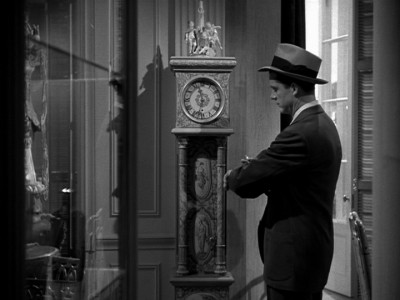
The picture we see under the credits is the portrait of a dead woman who in life was a smart, successful, superlative feminine beauty who'd been the object of a long-running, Pygmalion-like obsession gripping an older man, the witty, sophisticated, and cruel Waldo Lydecker (Clifton Webb), a widely-read high-culture newspaper columnist. We've seen that Laura now looks down on us angelically from some heaven; she will in that state become just such an ecstatically maddening object for the detective, a crusty loser in love called Mark McPherson (the pugnaciously handsome Dana Andrews, The Best Years of Our Lives), investigating her murder. The wasp-witted Lydecker, an aging sophisticate whom, he tells us in his opening voice-over, is "the only person who ever really knew Laura," is the first suspect we see McPherson interview; through his recollections, the first third of this remarkably lean, sleek film (running time only 87 minutes) becomes a Citizen Kane-like flashback depicting Lydecker's meeting of Laura as a bright-eyed, bushy-tailed 18-year-old peon of the advertising world, angling pushily, like someone ambitious with nothing to lose, for his famous-writer's endorsement. Then come her professional and social climb, aided by the besotted Lydecker, who could apparently feel his ice-entombed heart melting under her beauty and her sincere belief that he couldn't possibly be as scabrous and cruel as he seemed; a triangulating complication follows in the form of Laura's physical attraction to her middle-aged aunt's (another suspect) kept man, Shelby Carpenter (a perfectly louche Vincent Price, yet another suspect), which drives Lydecker's insecurity over his age, relative attractiveness, and his tenuous hold on Laura to the breaking point. He becomes calculating and cruel in his attempts to undermine Laura's belief in the almost blatantly gold-digging, treacherous Carpenter, to whom she has recklessly become engaged as a hapless assertion of her independence from Lydecker's oppressive tutelage.
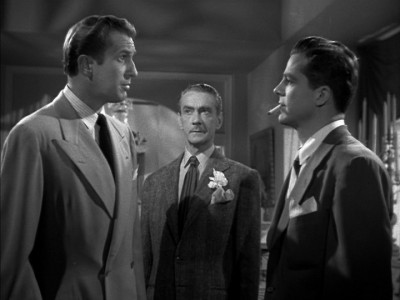
Preminger does a slow-burn delineation of Laura's suffocation between these two unsuitable but captivating men, smoothly accruing a sense of palpable foreboding, but what seemed to be the impending death of her free spirit at their hands has apparently occurred in much more physical terms -- a gruesome shotgun blast to the face (unseen by us, of course), that left her corpse unidentifiable and brought McPherson onto the scene to investigate the crime. The detective keeps a silent, vigil-like watch over her apartment, where his curiosity and evident arousal as he rifles through her things (more mysterious objects to be gotten to the bottom of) make us wonder at first if it's only some tipsy, turned-on dream of his that seems to bring Laura back to life.... For, in a moment that changes everything, Laura interrupts the nap McPherson is taking beneath her imposing portrait, ducking into her apartment from the rainy night, calm as you please in her slicker, fresh from a few days in the country to escape the pressure of her love triangle. The questions this raises -- who, exactly, was murdered in her apartment, by whom, and why? -- are overshadowed by McPherson's trepidant, fraught curiosity about the real-life Laura as opposed to the idealized image spun by Lydecker and his own fantasies, as well as the danger that his own attraction to Laura will either be burst by her necessarily mortal, human reality or, even worse, take on the collector's possessiveness that holds Lydecker writhing in its twisted grasp.
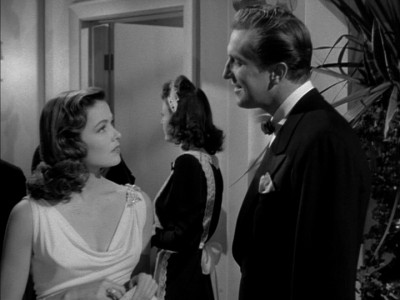
That possessiveness is just one of the many attributes and themes that Preminger -- his already sure (after only a few prior features) auteur's hand guiding cinematographer Joseph LaShelle ( Marty) and editor Louis Loeffler (who also cut Preminger's Anatomy of a Murder and The Man with the Golden Arm) -- ingeniously delineates on purely, powerfully visual terms throughout the film. The first thing revealed to us by Preminger's and LaShelle's fluently mobile camera, after those Laura-dominated opening credits, is the arid, sarcophagus-like chamber of Lydecker's apartment; it roams around for a good, long, languorous look at Lydecker's cases of ancient figurative art objects and towering bookshelves before finally revealing the intrusive human presence of Detective McPherson, examining with a skeptical eye this impressive, carefully cultivated surface -- something that the film itself is actively engaged in, too. The mise-en-scène is unemphatically yet unignorably replete with physical manifestations of the story's themes: A carefully mounted series of masks on Lydecker's wall and a grouping of framed silhouettes at Laura's cabin (one of which McPherson idly removes and examines the back of, as if looking for what might lie behind that shadowy surface of representation) parallel the overarching spectre of that portrait from the beginning, all of them symbols of petrified representations of human figures that draw the focus of an observer, aggravating curiosity and instigating a perhaps destructive need to investigate, touch, pin down, and own.
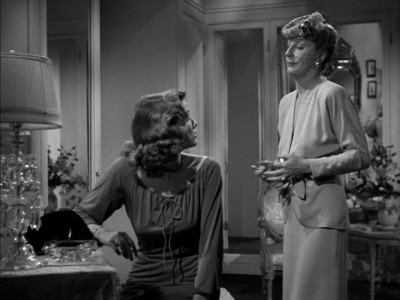
Preminger masterfully harnesses all the technical and creative richness afforded him by the well-equipped Fox studio lot to craft an experience whose foregrounded murder-mystery plot always casts a deep and strange shadow, further layers of potential meaning subtly but well evinced by Preminger and company's lighting and art direction, the dreamy, unpredictable tempo to which they set the plot and performances -- their exquisite shaping and texturing of the film's world. (The startling, disturbing reframing to the film's final image of an extremely fine antique clock -- a signifier supreme of rare, beautiful artifice -- smashed open to expose the mechanical cogs and gears inside, is in itself enough to ponder and obsess over and re-interpret for days, and it's only one example among many such swift and sure-footed visual moves we're treated to courtesy Preminger.) And, even by the high standards of an era when the studios were a well-calibrated, vertically integrated machine just waiting for their ripe resources to be turned to breathtaking artistic ends by filmmakers from Lubitsch and Preminger to Minnelli and Hawks to Hitchcock himself, the film is a highly accomplished production: The camera moves with a unique grace and agility through the brilliantly imagined and thoroughly realized sets and scenes, precisely calibrated to pan from one character to the next, or to slowly zoom from a crowd-framing to isolate just two faces, in a way that maximizes the emotion and meaning of what's occurring (the swish pan that reframes the screen from mysterious, beautiful Laura in her evening loneliness to a lurking threat is a masterful release of suspense and yet another reiteration, almost subliminal in its physical power, of something disturbing that always lies just outside the frame of even life's most splendid-looking stagings and well-appointed environments).
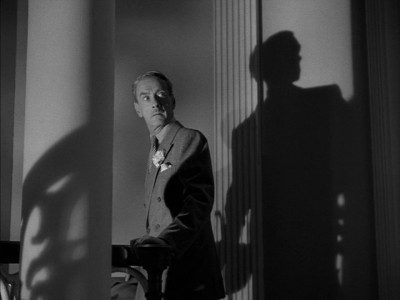
The core of Laura's world, the presence that motivates everything, is Tierney's presence and performance; it's her film, even though she's onscreen noticeably less frequently than her male costars (much of the plot seems to have been constructed to strategically delay and build in intensity toward the jouissance of Tierney's finally appearing in the flesh, so that that privileged moment has maximum significance and impact). Laura finds the lustrous Tierney, with her savored, sultry line deliveries and dark beauty, at her prime, coming off of one triumph in Lubitsch's Heaven Can Wait and headed toward another the following year in John M. Stahl's Leave Her to Heaven*. It was neither the first nor the last time Tierney would benefit from her director's own implicitly erotic devotion to her (Preminger's fanatical and insistent adherence to his personal screen-siren "Lauras" would almost ruin his career when he dug in his heels over a subsequent would-be Tierney, Jean Seberg, for the much-panned Saint Joan (1957) and Bonjour, Tristesse (1958)). That's not to say that Laura is anything so mere as a "star vehicle," however. Tierney is but the catalyst, the centrifugal force that causes the film to feverishly unfurl itself out into a web of complex emotions, hidden fears and desires, and some deeply troubling suggestions about love, lust, and romance. It's alluringly symmetrical and finely, impeccably spun on its surface, and all the more enthralling for its treacherousness and the dangerous surprises it holds in store; Laura's web is one in which it's a pleasure to find oneself drawn, again and again, to be happily ensnared.
*Thanks to Bennett Testa for correcting my initially posted review: John M. Stahl, not John Sturges, directed Leave Her to Heaven.
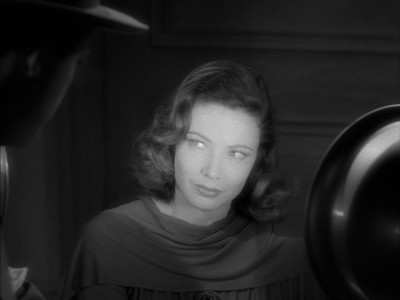
The Blu-ray disc's AVC/MPEG-4, 1080/24p presentation of Laura, at its original shooting aspect ratio of 1.33:1 (projected theatrically at 1.37:1 to accommodate a soundtrack strip not applicable to digital home media), looks stunning, the image clear, crisp, and pristine in every frame, the gorgeous noir-darks and chiaroscuro contrasts of Joseph Lashelle's cinematography beautifully variegated and solid -- and all without, to my eye, any stripping away of celluloid texture/grain in the clean-up process. It's pretty much as close as we'll ever get at home to the way a newly-struck print of Preminger's film would look run through a projector; it's a ravishingly cinematic experience.
Sound:The DTS-HD Master Audio 1.0 soundtrack is a vivid and precise presentation of the original mono elements, which are preserved without a scratch, crackle, or hint of hiss at any point; the dialogue is clear and immediate (Gene Tierney's voice is a musical instrument unto itself, and you get the full timbre here), and David Raksin's swoony-obsessive score's resonance and sonorousness are untainted by even the slightest blaring, distortion, or imbalance. The conscientious job Fox has done here makes the film as much of a pleasure to listen to as it is to look at.
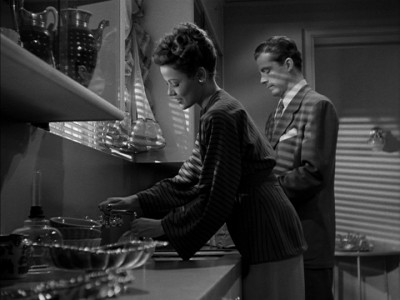
The Blu-ray edition of Laura features only one new extra, a 12-minute short piece called The Obsession, a standard-issue DVD supplement consisting of a celebratory run-down with film historian James Ursino, professor Drew Peters, and others praising the film with clips cut in. (The copyright date on this is 2005, so it could have been prepared for the DVD and then left off due to space limitations that are not a problem on Blu-ray.) Otherwise, all of the supplements from Fox's 2005 DVD edition are grandfathered in, including:
--Two feature-length audio commentary tracks. The first features film scholar/professor Janine Basinger and composer David Raksin, with Basinger performing a fairly basic but astute exegetic/descriptive function and Raksin providing anecdotes and his interpretation of the film. The second, much more vital commentary (you could throw on the Basinger/Raksin one and listen to it intermittently while you do your housekeeping; this one is a sit-down-and-pay-attention affair) is by film historian Rudy Behlmer. From his sometimes minutely detailed accounting of the film's evolution from novel to B-picture to high-budget "A" status to his explication of the romantic resonance of the name "Laura" as the name of a lost love invoked, mantra-like, by the 14th-century Italian poet Petrarch, Behlmer offers up a breadth and depth of backstory that's well-organized and highly engaging and enlightening.
--Two episodes from A&E's Biography series (approximately 45 minutes each): "Gene Tierney: A Shattered Portrait," in which Tierney's life, her success, beauty, acclaimed stage and film career, and personal struggles (with depression and failed relationships) are recounted through a bevy of intriguing clips from some of her best films and through the interviews with her sister Patricia Byrne, ex-husband Oleg Cassini, and daughter Christina Cassini. It's not so much about the films themselves, though film scholar Jeanine Basinger (one of this Blu-ray's commentators) is on hand for what discussion of Tierney's onscreen persona and filmography there is. "Vincent Price: The Versatile Villain," follows the same format, recruiting Price's daughter Victoria, actress Jane Russell, Price's friend/art-collecting protégé Dennis Hopper, and others to share their reminiscences about the actor, alongside plenty of personal photos from Price's offscreen/offstage life, and movie clips to remind us not only of his longevity as a macabre, faintly European-accented (he was actually American) human signifier of ghoulishness, but also his late-career collaborations with Tim Burton and Michael Jackson (and, most fitting for this release, perhaps, that he was the go-to costar for Gene Tierney after Laura, appearing alongside her in both Leave Her to Heaven (1945) and Dragonwyck (1946)).
--One approximately two-minute deleted scene (also viewable re-integrated into the film if you select the "extended version" in the set-up menu) depicting Lydecker's transformation of Laura (à la Scottie's molding of Madeline in Vertigo) into a well-dressed and poised upper crust girl; optional commentary by Behlmer explains that this sequence was removed out of worry that such a frank depiction of luxury would offend wartime viewers, particularly soldiers watching the movie overseas.
--The film's theatrical trailer, a fairly typical affair with hyperbolic narration that serves the double purpose of highlighting how much better the excerpted scenes look in the beautifully restored and transferred film than they do as we glimpse them here.
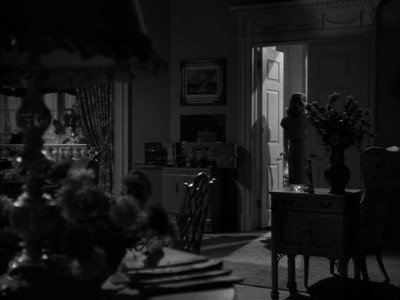
The great Hollywood director Otto Preminger's first "big" movie, 1944's Laura boasts 1001 well-considered and -wrought stylistic flourishes that make it a virtual template for film noir. But it also has its own moody allure to distinguish it, its own superb craft and cleverness in the way it scatters its murder-mystery plot like crumbs, forming a trail that we take up and follow helplessly -- a path that leads us into some dark woods indeed, toward some visually and dramatically ravishing but highly unsettling realizations, whether about its characters in specific or, more profoundly, about the tenuousness, the extreme fragility of any confidence we can have about "knowing" another person, even (or is it especially?) someone who's earned our romantic devotion and/or erotic obsession. The film fits very well into the noir category, but like so many great films answering to that description that came in its wake, it well overspills the categorization, adroitly using its nighttime settings, raininess, hard-bitten and overly ambitious characters, and ambivalent motives that only become more obscure and complicated -- all the stylistic hallmarks of the noir tendency -- as means to its own end, ways to pull us inexorably toward its own specific heart of darkness. Along with Billy Wilder's also-noirish Double Indemnity, Laura is the most exemplary, perfect, stunning-looking "A"-picture iteration of the WWII/postwar-era cracks in the love-conquers-all assurance of American cinema, a sharp bead drawn on those troubled, anxious nighttime moments of deep matters starkly pondered and seen all too clearly. It's a drama with all the usual love-loss-death conflicts, transfigured through the filmmakers' breathtakingly fluent use of the medium into something with the disturbing, inconsolable power of a torch song, or a poem, or a nightmare. DVD Talk Collector Series.
|
| Popular Reviews |
| Sponsored Links |
|
|
| Sponsored Links |
|
|
| Release List | Reviews | Shop | Newsletter | Forum | DVD Giveaways | Blu-Ray | Advertise |
|
Copyright 2024 DVDTalk.com All Rights Reserved. Legal Info, Privacy Policy, Terms of Use,
Manage Preferences,
Your Privacy Choices | |||||||









